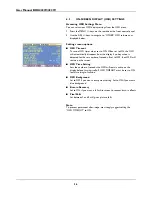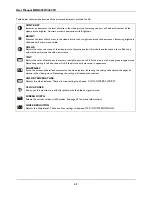
User Manual BDH4222V/4223V
29
7.4
UNDERSTANDING HDTV
What is Digital Television or DTV?
Digital TVs are televisions that can receive and display digital television
broadcasts sent using any one of three following categories:
HDTV (High Definition TV), EDTV (Enhanced Digital TV), and SDTV
(Standard Definition TV).
What is the Difference Between HDTV, EDTV, and SDTV?
HDTV, EDTV, and SDTV are three grades of televison or monitors.
They reference the maximum resolution capability of a digital television
or monitor to fully display digital broadcasts without having to “down-
convert” the actual signal content to fit the monitor’s display limitations.
The resolution requirements for each of the three DTV classifications
and an explanation of the specifications are described below:
HDTV grade televisions and monitors are capable of displaying a
maximum of either 1080 lines using interlaced scan method or 720 lines
using progressive scan method.l
EDTV grade televisions and monitors are capable of displaying a
maximum of 480 lines using progressive scan method. All resolutions
higher than 480 lines must be reduced to 480 lines in order to be
displayed. Progressive scan method reduces flicker; however, picture
quality may not necessarily outperform 480 interlaced when viewed at
normal viewing distances.
SDTV grade televisions and monitors are capable of displaying a
maximum of 480 lines using interlaced scan method. All resolutions
higher than 480 lines must be reduced to 480 lines in order to be
displayed.
1.
Vertical Resolution (Scan Lines)
Vertical scan lines refer to the number of horizontal lines a TV or monitor can display to
create an image. As the number of lines increase, more information is displayed, resulting in
better picture quality.
2.
Horizontal Resolution
Each horizontal line in a TV or monitor is made up of individual dots (pixels). The higher the
number of pixels, the finer the TV picture becomes. Horizontal pixel measurements using
today's technology can range from 250 for a VCR to as much as 500 for a DVD player.
3.
Aspect Ratio
Aspect ratio identifies the ratio of the TV screen's width over its height. A 16:9 aspect ratio
refers to a wide-screen picture format, while a 4:3 refers to a standard “square” TV format.
4.
Scan Mode
Interlaced scanning is a method that creates a TV picture with alternating lines of
information and is the cause for flickering. Progressive scanning is a method that creates a
TV picture with consecutive lines of information that results in flicker-free picture quality.
Vertical Res.
1
Horizontal Res.
2
Aspect Ratio
3
Scan Method
4
1080 lines
1920 dots
16:9 Wide
Interlaced
720 lines
1280 dots
16:9 Wide
Progressive
Vertical Res.
1
Horizontal Res.
2
Aspect Ratio
3
Scan Method
4
480 lines
640 dots
4:3 Wide
Progressive
Vertical Res.
1
Horizontal Res.
2
Aspect Ratio
3
Scan Method
4
480 lines
640 dots
4:3 Wide
Interlaced
Summary of Contents for 42-WXGA PLASMA MONITOR BDH4223V-27B
Page 1: ...Philips Business Solutions User Manual EN TYPE Nr BDH4222V BDH4223V ...
Page 2: ......
Page 10: ...User Manual BDV4222V BDH4223V 6 ...
Page 16: ...User Manual BDH4222V 4223V 12 5 2 REAR VIEW MAIN POWER ...
Page 20: ...User Manual BDH4222V 4223V 16 5 2 REAR VIEW MAIN POWER ...
Page 30: ...User Manual BDH4222V BDH4223V 26 ...
Page 52: ...User Manual BDH4222V 4223V 48 ...
Page 62: ...User Manual BDH4222V 4223V 58 ...






























